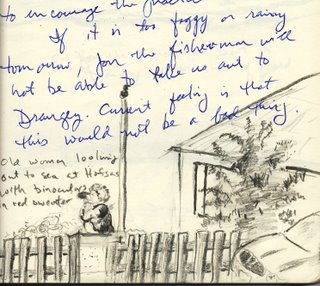
Still foggy. With a growing sense of relief I call Farmer Jon. (Why is he called Farmer Jon, when he is a boat captain? That's because he owns a farm on the fjord, an ancient one called Fagranes, where the body of Grettir is supposedly buried. Grettir's head is elsewhere.) Farmer Jon, his sons, and other assorted relatives man the boat when it goes out, in addition to farming. Similarly, Valgeir's daughter got us settled in our lodging because Valgeir and Gudrun, her parents, were out on their farm doing end-of-summer farm chores.
I ask Farmer Jon's son if our trip will be postphoned due to the fog. "We will go, absolutely," he says. We quickly pack our warm clothes and lunch, and drive around the fjord to the harbor, in such a rush that there isn't time to worry. We pull away from shore in a small boat with about 20 other people on board.
The trip is windy, cold and wet. Water splashes into the small craft; my jeans are soaked before we even arrive at Drangey. The trip takes a little more than an hour. I am feeling r
 eally keyed up, between excitement at seeing the sight I have longed to see the most in Iceland, and a great deal of nervousness regarding the dangerous climb ahead. Gabe and Pete compare notes along the way.
eally keyed up, between excitement at seeing the sight I have longed to see the most in Iceland, and a great deal of nervousness regarding the dangerous climb ahead. Gabe and Pete compare notes along the way.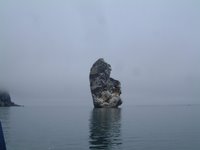
First we glimpse the tall escarpment next to Drangey, then Drangey itself rises majestically out of the mist. We hear an incredible din...the sound of millions of birds swooping and calling. The cliffs of Drangey are whitewashed in huge swatches. After sailing alongside a number of craggy inlets our boat pulls up to a dock, where we are dwarfed by the vertical cliff at our side.
Our g
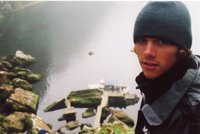 uides up Drangey are Farmer Jon's son and his nephew. Jon himself is about 75 years old, and has made the climb thousands of times. He may be old enough to enjoy staying back on the boat this trip, but he is still "frisky," as Bill Holm describes him...after all, he has a son who is 20 years old. We thought Steinn was Jon's grandson but Holm enlightened us: "that's his son, the sly Fox!" Steinn and Ajalti shepherd us up the cliff, carefully providing assistance or confidence to those of us who are feeling less than heroic.
uides up Drangey are Farmer Jon's son and his nephew. Jon himself is about 75 years old, and has made the climb thousands of times. He may be old enough to enjoy staying back on the boat this trip, but he is still "frisky," as Bill Holm describes him...after all, he has a son who is 20 years old. We thought Steinn was Jon's grandson but Holm enlightened us: "that's his son, the sly Fox!" Steinn and Ajalti shepherd us up the cliff, carefully providing assistance or confidence to those of us who are feeling less than heroic.John describes the path:
...daunting, but not as frightening as we had feared. The slope is steep, and wooden boards are dug into the earth, or primitve stairs, switchback up. Ropes are fastened to poles a good way to give some security. An iron rod is driven into the cliff at one tight turn to grip. The last 40 or 50 feet take us up a steel pipe ladder that is vertical.A short way into the climb we encounter a little alcove/altar in the rock, with a large bronze plaque that has the Lord's Prayer in Icelandic. One of our party is a baker from Reykjavik--the only supplier of natural sourdough bread in Iceland--and he drops to his knees and crosses himself as he prays (he has completed this climb previously, so presumably knows the need for divine intervention). I ask Steinn if it must be prayed in Icelandic and he reassures me: "I think He speaks many languages."
We arrive at a large meadow. All of the island is covered in lush green grass that you sink into up to your knees. Wildflowers and colorful mosses are everywhere. To our surprise, it isn't just one or two meadows atop the huge cliffs: it is one followed by another which you reach by climbing little hills. There are about five meadows in all, but in each one you can see just the one that you are in. I had thought that the best view of the day would be arriving back at the harbor alive, but I was wrong. The best views of the day are on Drangey!
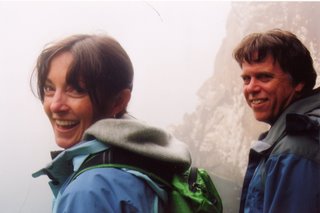
The group of us wanders from meadow to meadow, and we gradually regroup in the grassy area that contains the rocky remains of outlaw Grettir's abode. A plaque informs us that here he lived, and died in the year 1037.
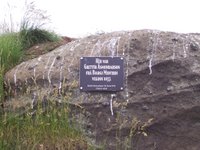 We sit or lay down in the grass and listen to Steinn relate the story of Grettir.
We sit or lay down in the grass and listen to Steinn relate the story of Grettir.Steinn is an art student who wears Buddy Holly-style glasses. (Cousin Ajalti is an appealing 15-year old, following in Steinn and Jon's footsteps--fast becoming a competent guide and storyteller himself.) Steinn's sense of humor is dry, and his descriptions are sometimes quaint. When he talks about Grettir's half-brother being put in prison, he calls it a "dirty basement." He refers to the bewitched log with runes that was Grettir's undoing as "bad wood." Steinn is competent in 4 or 5 languages, and easily switches from one to another as he tells the story in 2 languages, with asides and explanations in several others. I sit rapt at his feet. I know the story and anticipate each event as he relates it. It completely chokes me up to find myself here, in the place where Grettir once lived, hearing his story told in person by someone who grew up climbing these cliffs and hearing this story. Steinn does the tale perfect justice in his telling of it.
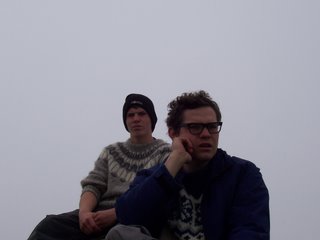
As we continue our walk along the periphery of the island I think that it would be impossible to be any happier than I am right now. The clouds are low, so that we can seldom see the water below. While it is unfortunate not to see the 360-degree views of the huge fjord, it is wonderful in a different way. The height isn't so scary, and we feel warm, cozy and enclosed in our own little world on the island.
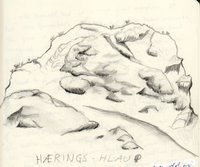
We see Haering's Hlaup, and as we sit in the meadow to rest and eat, John sketches the Hlaup, or Leap, where Haering escaped Grettir and found death on the rocks below. Steinn compliments John's art. In return, we teach Steinn and Ajalti cool US slang such as "the Whole Steamboat" and "Boy Howdy!" No doubt these will come in useful for them when they want to impress female tourists.
At one point Steinn reaches in a little hummock where birds nest and pulls out a baby fulmar, all white. "He spits a vile-smelling vomit on you," he informs us. When we ask if the mother will return to the nest after he has handled the baby, he gives a philosophical "who knows" shrug.
Ajalti is spending the next week on the island with his father, puffin hunting (which they do with nets at the end of long p
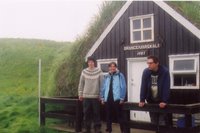 oles, catching the birds as they fly). They will stay in a little hut on one of the meadows, which has several bunks, a kitchen and a loft. Everything must be hoisted to the top of the cliffs via a winch and long cable from the dock. There is a guest book, which we sign. We get much closer to puffins, here on Drangey, than we ever imagined that we might. They are everywhere here, by the hundreds of thousands.
oles, catching the birds as they fly). They will stay in a little hut on one of the meadows, which has several bunks, a kitchen and a loft. Everything must be hoisted to the top of the cliffs via a winch and long cable from the dock. There is a guest book, which we sign. We get much closer to puffins, here on Drangey, than we ever imagined that we might. They are everywhere here, by the hundreds of thousands.
The descent is worse than the ascent, but not by much. We see seals on our boat trip circling the island on the way back, and more birds.
When we get back to harbor in Saudarkrokur, we feel we can't miss the opportunity to drive 20 km up the coast to Grettir's Laug, or pool, which is a natural hot spring. It has been nicely fixed up with stone benches inside and out. It is right on the edge of the shore. After Gabe and Peter get steamed in the pool, they actually get into the ocean to cool off! (Not for long, though.) There are two sod roof cabins with bathrooms, kitchen, and changing areas as well. All this, out in the middle of nowhere!
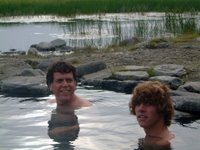
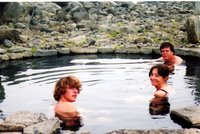
We call back to Solvik restaurant in Hofsos, afraid that we will arrive too late to be able to dine there. They assure us they will stay open to await our arrival. We don't want to miss Bill Holm's recommendation of the best fresh trout around. We aren't disappointed: it IS the best fresh trout around, and probably one of the best meals we will have in Iceland.
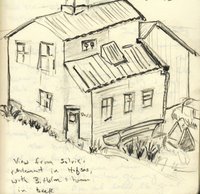
A perfect day. The reason why I came to Iceland. Heaven!
2 comments:
I enjoyed reading thiss
And I enjoyed re-reading it and reliving it, thanks to you!
Post a Comment